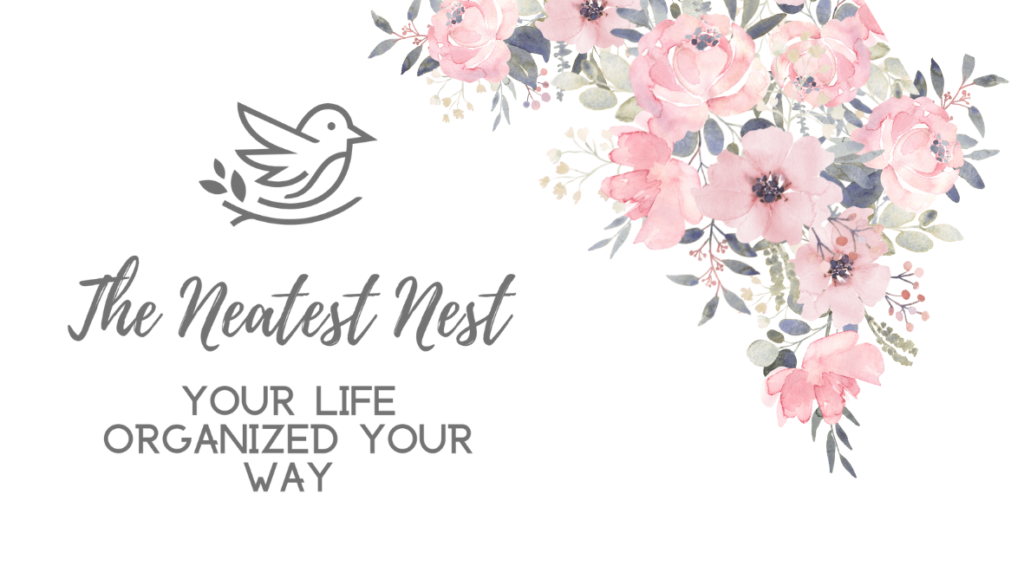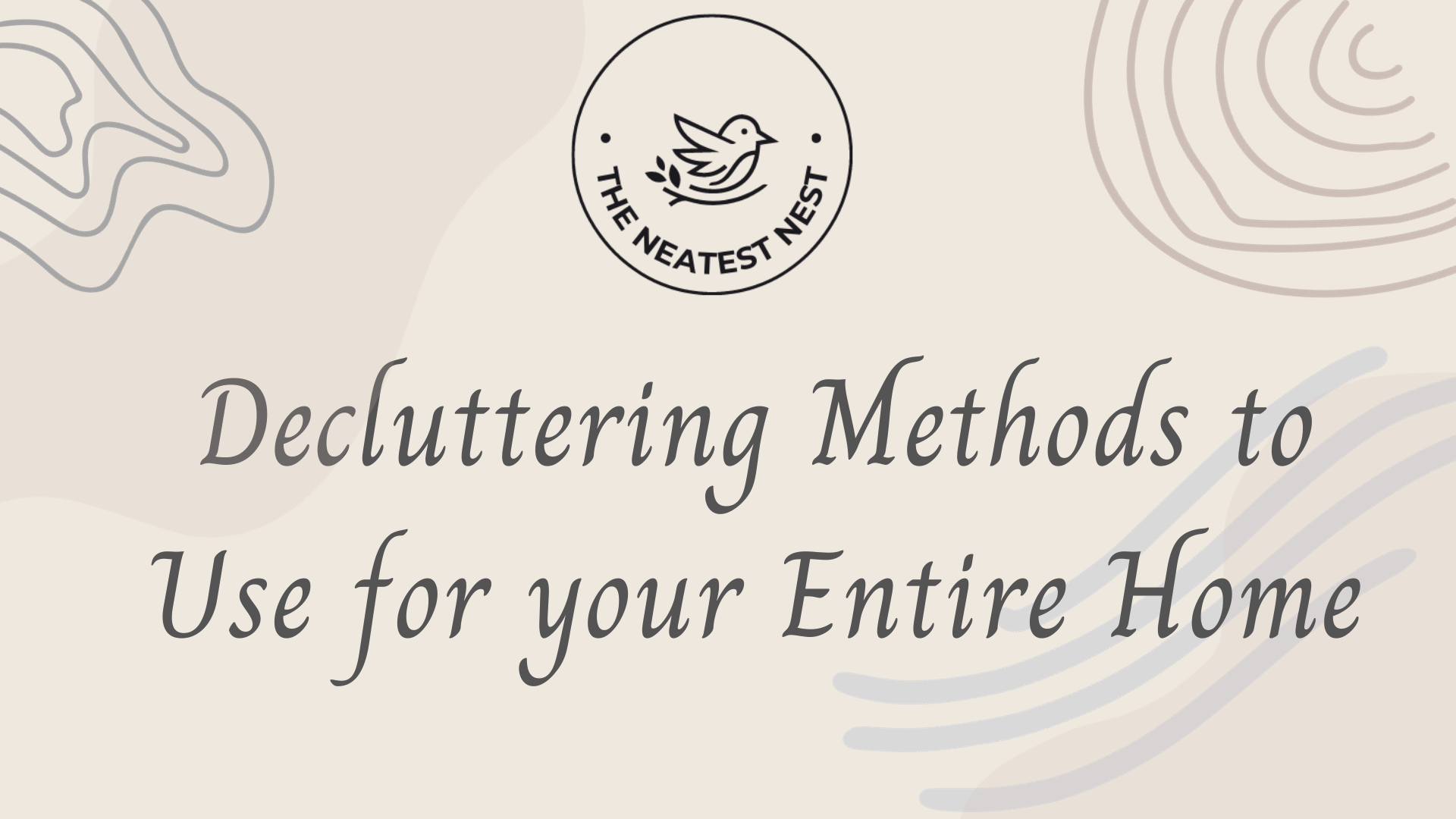Why Using a Decluttering Method is a Good Idea
The three decluttering methods I will describe below have all been used to help people reframe how they feel about their belongings in some way or another. When people think of decluttering their home, they usually get rid of the garbage, things that are expired, broken, stained, etc. That is a great first step. However, what it takes to REALLY declutter is to imagine the home and life you want to live and then create that reality.
Oftentimes you need a prompt to change your way of thinking or simply some reasoning that you feel gives you permission to finally let go of the items you’ve collected but no longer need. Using one of the methods or a combination of the methods below can spark that in you.
The KonMari Method
Ahhh…Marie Kondo. We’ve all heard about her method by now. When her book ‘The Life-Changing Magic of Tidying Up’ came out in 2014 and then her TV show in 2019, she caused quite a stir. Her decluttering method is simple–only keep items that ‘spark joy’. It sounds easy enough, but she is the ultimate minimalist and it’s very hard to declutter to that level for most people. If we take her method with a grain of salt and a pinch of reality, it can be very helpful in getting rid of superfluous items and keeping your home neat.
Her method consists of the following steps:
- Commit yourself to tidying up.
- Imagine your ideal lifestyle.
- Finish discarding first. Before getting rid of items, sincerely thank each item for serving its purpose.
- Tidy by category, not location.
- Follow the right order.
- Ask yourself if it sparks joy.
She recommends doing the categories below in this specific order:
- Clothes
- Books
- Papers
- Komono (Miscellaneous Items)
- Sentimental Items
Her decluttering method starts with taking everything in each category out and going through each individual item. For example, when doing clothes, take all of your clothes, pile them on your bed, couch, floor, whatever and sort through each piece. I personally love that way of doing things. By taking everything out, it forces you to deal with every item. It gives you a great visual for how much you really have and makes it easier to downsize.
A huge takeaway for me when reading the Marie Kondo book was realizing the items I was keeping out of guilt. When I searched for joy in each of my items, it helped me see clearly the objects in my life I was saving out of guilt. They were no longer serving me. In fact, they may have NEVER served me and the type of life I want to lead. It’s OK to thank the item for its service and let it go.

Swedish Death Cleaning
Next up in our discussion of decluttering methods is one you may not have heard about. It is called döstädning (death cleaning). This method originates from the Swedish artist and author Margareta Magnusson. The core purpose of döstädning is for seniors to downsize their possessions so that they will not burden their children with sorting through their belongings when they pass away.
It sounds pretty morbid, but it’s actually quite thoughtful. It helps the children in the future and allows the seniors to live an uncluttered life surrounded only by the things they truly love. It’s quite similar to the KonMari method in that way.
Of course, this type of cleaning does not have to be limited to people in their elder years. You don’t even need to have kids for this method to work for you!
When using this method, here are some of the questions you can ask yourself:
- Will my children (or future children) want this item?
- Is this item of sentimental value?
- Is this item worth money?
- Do I love this item and need it in my life?
- Will this burden my children (or future children) in the event of my death?
- Do current or future generations have a need for this item?
Considering Generational Changes
It’s important to understand the current generation or imagine what the future generations may look like. You may have amassed a giant VHS movie collection in your day. However, that technology is now obsolete. I suggest digitizing any home videos you want to preserve and sending the rest of the tapes to the dump. Neither you or your children have a need for those tapes in this day and age.
Another generational example is china cabinets and china collections. It was common in my parents’ generation to have a formal set of china stored in a large cabinet. In my generation, it was less common but still seen. In the current generation, you do not see that at all. Young adults now are more casual, practical and minimal. They are focused more on having experiences and living life than collecting possessions.
If you have a beautiful set of china that you don’t use and don’t want your children to feel burdened with, you should find a home for it now or sell it. Don’t leave it to them to have to figure out what to do with it. That’s the point of the death cleaning.
Other Considerations
This is meant to be a slow and methodical whole house cleaning. Don’t try to tackle it all in one weekend. Magnusson views it as a lifestyle change more than a quick clean out. It is meant to benefit your offspring, but the offshoot is living a more streamlined and organized life.
Speaking of death, you should use this time to make sure that you have communicated your end-of-life wishes to your family. In addition, you should make a will and think about any inheritance you will leave behind.
If there are items you do not have a use for but planned on leaving to a loved one when you pass, why not give it to them now? For example, a piece of jewelry you never wear. How nice would it be to see the person you love wearing it instead of it sitting in a box until you pass away?
The author also suggests that you vocalize to your family & friends what you are doing. This way they can hold you accountable and ensure you are making progress.
Stage a Fake Move
The final one of our decluttering methods is staging a fake move. I do not know where this idea originated from, but I first heard of it on the Happier podcast that is hosted by my girl, Gretchin Rubin and her sister Elizabeth Craft. The idea behind this method is to think about what you would want to bring to a new home if you were moving. Imagine that you are downsizing in your new home so that you only take what is essential.
When you analyze your belongings ask yourself these questions:
- Do I want to pack this item?
- Do I want to move this item (and possibly pay someone to move it for me)?
- Would this item sit in a box for a while before I unpacked it?
- Where would it go in my new home?
- Does this item reflect the kind of lifestyle I want to live in my new home?
When you give yourself these parameters, you see your items in a different light. It may give you the permission you’ve been seeking to free yourself of things that are bogging you down. Also, take the time to visualize your ‘new home’ and the type of environment you want it to be. This can give you insight into how you wish you were living and help you to create that life within the space you have now.
A Note About Minimalism
All of these decluttering methods have a common thread. They advocate minimizing your possessions. That can be overwhelming for people who have emotional attachments to things. Likewise for people who enjoy having a lot of ‘stuff’ around. Not everyone buys into the minimalism trend. The good news is, you can keep anything you like, as long as it brings you joy and helps you lead the kind of life you want.
For example, if you have a large book collection that you have curated through the years, no one is suggesting you only keep 10 books. Rather, if having those books bring you joy, make a space for them to have a starring role in your home. Get rid of things that get in the way of displaying your books and keep you from having a space for enjoying them.
Same goes for a shoe collector, someone who loves to cook, or a fitness enthusiast. We want to make sure that clutter or misuse of space is not keeping you from enjoying what gives you happiness in your home. After downsizing your belongings and reorganizing, make certain you create space for displaying your treasures or participating in activities that bring you joy.
What Decluttering Method Resonates with You?
The organization method you use all comes down to which one motivates you to fully declutter and downsize. You may use advice from each of the methods and even come up with some of your own ideas. Once you commit to decluttering, I would suggest moving slowly. When you commit to getting organized and decluttering, it can be physically and emotionally draining. It’s not something you can finish in a long weekend. If you are trying to find homes for your items instead of bulk donating or throwing them away, it can take even more time.
The end result is a home with only essential items and things you love. You can now take them, organize them in a streamlined way and create the type of life you want to be living free of guilt, clutter, and unnecessary objects.
If you feel so inclined, drop a comment below on which method would motivate you. I love to hear feedback from readers!!
Resources
Note: The links below are my Amazon Affiliate links. I receive a small commission for any purchases made from these links. However, I will never recommend items I have not personally used myself or had experience with in some capacity.
If you’d like to get some more information on two of the decluttering books mentioned above, you can use my Amazon links below:
The Life Changing Magic of Tidying up – Marie Kondo
The Gentle Art of Swedish Death Cleaning – Margareta Magnusson
If you’d like to read more about cleaning out clutter and organizing your home some of my previous blog posts may help you:







Leave a Reply